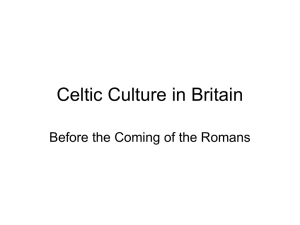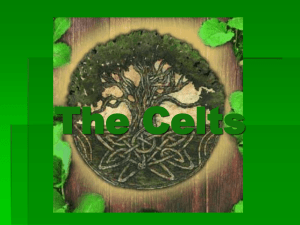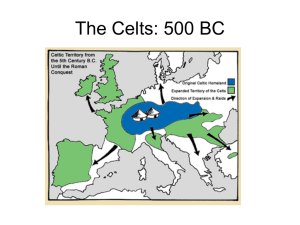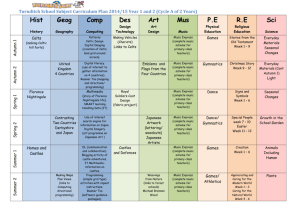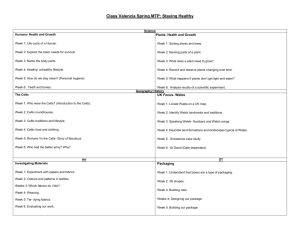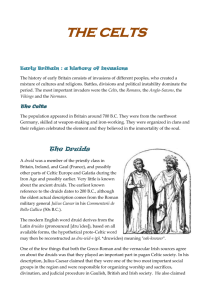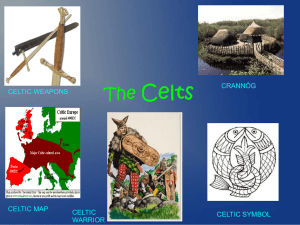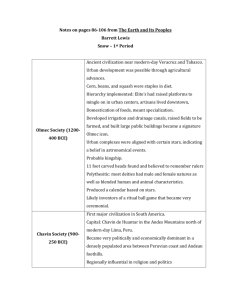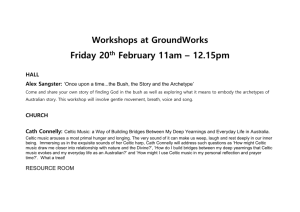The Celts
advertisement
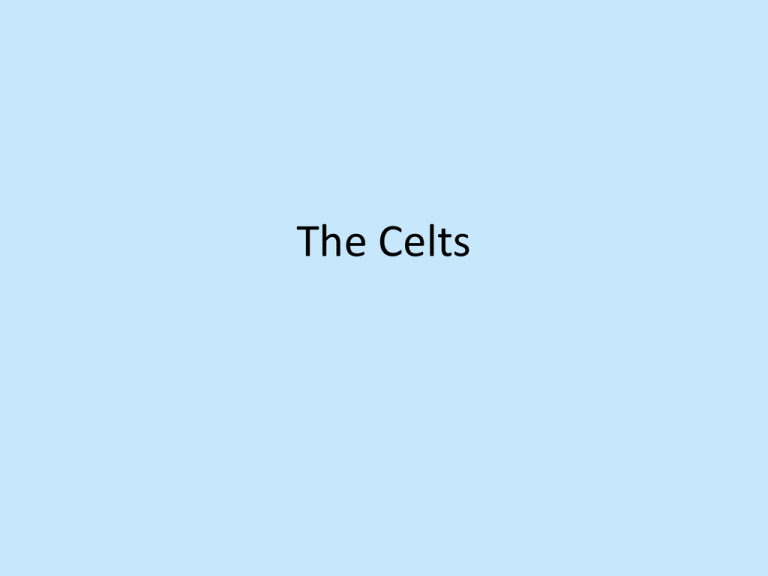
The Celts • • • • • • • Celts in Europe This map shows yellow -the core Hallstatt territory, expansion before 500 BC bright green maximum Celtic expansion by the 270s BC pale green- Lusitanian area of Iberia, "Celticity" uncertain emerald green -the boundaries of the six commonly-recognized 'Celtic nations', which remained Celtic speaking throughout the Middle Ages (viz. Brittany, Wales, Cornwall, Isle of Man, Ireland, Scotland) dark green-areas that remain Celtic-speaking today Atlas of the Celtic World, by John Haywood; London Thames & Hudson Ltd., 2001, pp.30-3 Where from? Time line • 1200 BCE Celtic way of life in Central Europe begins • 700 BCE The ‘Hallstatt’ transition from bronze to Iron • 450 BCE Iron age La Tène phase of Celtic culture. Celts under attack from Germanic tribes from east and Romans from south • 390 BCE Gauls sack Rome • 58BCE Julius Caesar invades Gaul – see Caesar’s Gallic Wars • 55 BCE Caesar invades Britain and is repulsed • AD/CE 43 Claudius invades • AD51 Caractacus capture • 60-61 Boudicca’s revolt • AD/ CE 400 Roman withdrawal from Britain begins • Late 400s Saxon incursions begin Celtic stronghold in the west • 433 AD/CE St Patrick in Ireland and Dai Riada ( SW Scotland)- what about Celtic culture in Ireland- flourished c 600, 700s and *d Sources of evidence- bias • Written sources from Greeks and Roman • Herodotus- 485-425 BCE Penguin edn. 108 , 256 brief mention ‘the most westerly people in Europe’.. ‘ along the Danube and ‘Beyond the pillars of Heracles.’ • ( Roman) Pliny the Elder 77 AD/CE • The druids consider nothing more sacred than the mistletoe and the tree that it grows on, so long as it is an oak. Mistletoe is actually very rare ion an oak tree and when it is found it is gathered with great ceremony in the first place the collection must take place on the 6th day of the moon.. A priest dressed in white climbs the tree, cuts the mistletoe with a golden hook and catches it on a white cloak Strabo a Greek Geographer and traveller c.64 BCE ‘ Most of the island is flat and overgrown with forests, although many of its districts are hilly. It produces grain, cattle silver and iron. These things according are exported from the island, as also hides ,and slaves and dogs that are by their nature suitable for hunting… besides some small islands round about Britain, there is also a large island, Ierne [Ireland] which stretches parallel to Britain • They wear ornaments of gold, torcs on their necks, and bracelets on their arms and wrists, while people of high rank wear dyed garments besprinkled with gold. It is this vanity which makes them unbearable in victory and so completely downcast in defeat.’ • Forest thickets are their ‘cities’ The fe4nce round a wide clearing with felled trees and here they make them selves huts and keep their cattle Roman written evidence • Caesar – Gallic Wars • . "In chariot fighting the Britons begin by driving all over the field, hurling their spears. The terror caused by the horses and the noise are enough to throw their enemies into disorder". The chariot drivers also impressed Caesar: "Even on a steep slope they are able to control the horses at full gallop and turn them in a moment". • Tacitus Annals of Imperial Rome (Penguin edn.) 328-331 Suetonius attacks the Celtic religious stronghold of Anglesey ( Mona) • On the shore stood the opposing army with its dense array of armed warriors, while between the ranks dressed women dressed in black like the furies, with hair dishevelled, waving torches, All around the druids, lifting up their hands to the heavens and pouring forth dreadful curses, scared our soldiers • • • Chariot lynch pin Mid-Late Iron Age, about 300BC-43AD Linch pins were used to hold the wheels in place on the axles of Iron Age chariots or Found with a metal detector at Upham, carts, and were often elaborately decorated.. The Romans were very impressed by the Celts' use of chariots in battleWe can only speculate on how this lynch pin came to be lost at Upham. Could it have become detached from a chariot in the heat of a long-forgotten battle, or did it perhaps fall off of an old abandoned cart at the side of an ancient track way? Length 120mm. Diameter Warfare , transport Caractacus- resistance to Rome • http://en.wikipedia.org/wiki/Caractacus • http://resourcesforhistory.com/caractacus.htm • Caractacus selected a hill fort, to fight a decisive battle with the Romans, where it was both easy for the Britons to move forward to attack the Romans but also to retreat if things did not go well in the battle. At the same time it would be hard for the Romans to attack or retreat. On the more gentle slopes the Britons piled up stones to make a rampart. The British warriors positioned themselves in front of these defences but they were still protected by a river which was in front of them. • The chieftains of the various tribes moved amongst their men encouraging them. Caractacus, darted everywhere, telling his men that this battle would be the beginning of the recovery of their freedom or else of everlasting slavery. He recalled how their ancestors had driven back Julius Caesar, and through their bravery the British were freed from the threat of being ruled by the Roman military and government. While he was speaking, the warriors shouted applause; every warrior swore not to flee from weapons or wounds. Archaeology Defence , power organisation, hill forts http://www.butserancientfarm.co.uk/ Houses, farming, food, clothes http://www.britishmuseum.org/explore/highlights/highlight_obj ects/pe_prb/l/lindow_man.aspx • • The conditions in the peat bog meant that the man’s skin, hair and many of his internal organs are well preserved. Radiocarbon dating shows that he died between 2 BC and AD 119. He was about 25 years of age, around 168 cm tall and weighed 60-65 kg. He had probably done very little hard, manual work, because his finger nails were well manicured. His beard and moustache had been cut by a pair of shears. There is no evidence that he was unwell when he died, but he was suffering from parasitic worms. His last meal probably included unleavened bread made from wheat and barley, cooked over a fire on which heather had been burnt. The man met a horrific death. He was struck on the top of his head twice with a heavy object, perhaps a narrow bladed axe. He also received a vicious blow in the back – perhaps from someone’s knee – which broke one of his ribs. He had a thin cord tied around his neck which may have been used to strangle him and break his neck. By now he was dead, but then his throat was cut. Finally, he was placed face down in a pool in the bog. This elaborate sequence of events suggests that his death may have been ritual killing. Some people have argued that he was the victim of a human sacrifice possibly carried out by Druids. Uffington White Horse- religion? Cerne Abbas Giant Evidence form Archaeology • http://www.britishmus eum.org/learning/scho ols_and_teachers/resou rces/all_resources1/resource_celtic_desig n.aspx • Jewellery, design, coins, military objects Ogham an ancient language found on Celtic stones Celtic place names • • • • • • • • • Car or Caer= fortress Tre= farmstead, town Aber = river mouth Pen= head Kil=church Avon= river Llan= religious enclosure Din, den, don dun stronghold Pol= pool • http://en.wikipedia.org/wiki/Celts • www.butserancientfarm.co.uk • • • • • • • • • http://www.bbc.co.uk/wales/celts/factfile/webguide.shtml http://www.bbc.co.uk/history/ancient/british_prehistory/ http://resources.woodlands-junior.kent.sch.uk/homework/celts.htm www.history.org.uk http://www.bbc.co.uk/history/handsonhistory/ancient-britain.shtml http://www.channel4.com/programmes/the-celts http://www.le.ac.uk/ar/stj/intro.htm http://www.english-heritage.org.uk/daysout/properties/maiden-castle/ www.keystagehistory ideas • Houses, food farming, • tribes, chieftains, druids, farmers social organisation • Jewellery and other objects • War • Religion pre Christian – sacrifices, river Gods. Horse images, Celtic Christianity • burials • Hill forts • language
